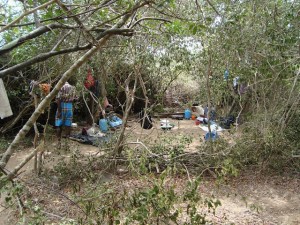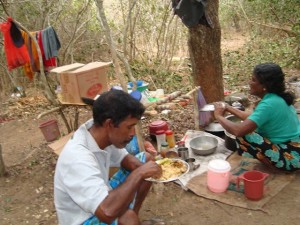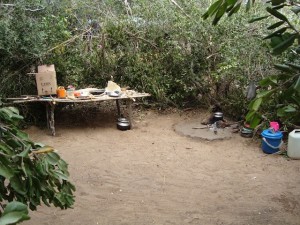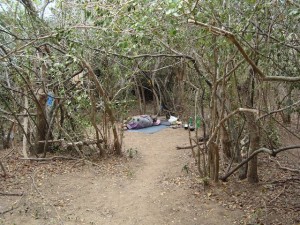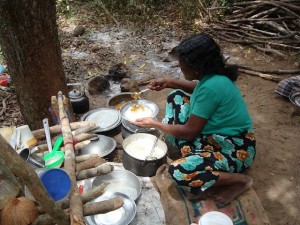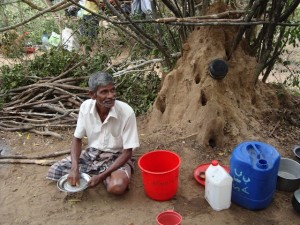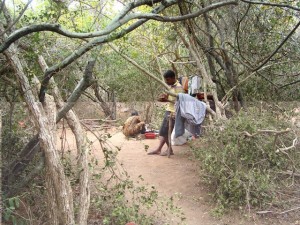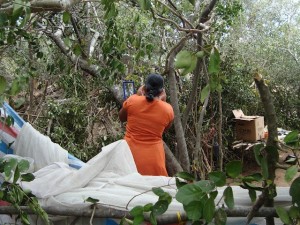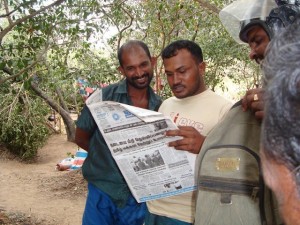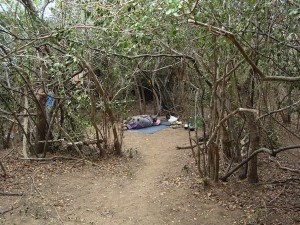In 2011, a young Advanced Level student from Mullikulam in the district of Mannar, living as an Internally Displaced Person (IDP) in a camp in Thalvupadu, Mannar, shared with me an assignment she had done about her village and effects of displacement. She proudly described the richness of her hometown in terms of natural resources, culture and traditions. But soon, her mood turned to one of despair as she asked me and a priest who was accompanying me, when they could go home.
Neither of us had an answer for her. We were both aware that Mullikulam had been under military occupation since September 2007. We have been visiting the people of Mullikulam on a regular basis since the time they were forcibly evicted from their village by the military, having being given very little hope of returning.
But inspired by the loving manner in which the villagers spoke about their village, and the teenager’s efforts to document the rich history of the village, the priest and I thought we could perhaps assist these villagers to write the story of their village. Both, the villagers and the Bishop of Mannar welcomed the idea, and pledged their continued support. I was working with Law & Society Trust (LST) at that time, and so approached two trusted and committed friends to join my team at LST, in carrying out hands-on research and writing. They assisted with documenting the story of the village, working closely with the villagers and Church leaders. In the process, we became friends and became involved in their struggle to return home.
Even through their utmost poverty and despair, we always received a warm welcome from the villagers. They never got irritated at our questions, nor failed to feed us and quench our thirst. Last Sunday, they even offered us a delicious lunch despite clearly not having enough food for themselves.
In May 2012, they were able to negotiate with the Navy to allow a newly ordained Priest to celebrate his first mass in the village. I was also invited and eagerly joined in the celebration. It was in a way a high point in my relationship with the villagers. I experienced once again the deep attachment to the village and the church these villagers had. But it was sad to see women and men holding on the barbed wire fence pout around the church to restrict access to the village. I saw villagers were looking lovingly at their own houses, cooperative store, community centre, school and other buildings that was within a few feet, but they were not allowed to access as it was occupied by the Navy. Though I was warmly welcomed by the villagers, I certainly didn’t feel much welcome from the Navy, who had surrounded the church and constantly watched me and my friends, and later questioned us, taking down our names, addresses etc.
In June, I received several calls from Mannar asking me when I planned on visiting Mullikulam as people had decided to go and settle at the edge of Mullikulam. I was finally able to go last week. As I spent a Sunday with them, first in their Church surrounded by the Navy, and then in their new abode in the middle of the jungle, I felt I had to write about my journey with them; what I had learnt, what I had seen, heard and felt. And about the struggle of the villagers to go home. Much of what I share is also the result of a collaborative the research by my team during my time at LST with the Mullikulam villagers and Church leaders in Mannar.
The story is not complete yet, as their struggle to return home continues. I hope that someday their whole account will be published.
Legality of occupation
Mullikulam villagers were forced to leave their village in September 2007 by the Sri Lankan Army. “We want to go home…to our land, sea, forests, houses, church” has been their consistent cry for five years now. First the Army, and then the Navy occupied Mullikulam. Occupied land includes private lands of people (legally owned by deeds, grants or permits), land belonging to the Catholic Church, as well as State land.
All lawyers I consulted said this occupation appears to be illegal, as measures set out in the Land Acquisition Act No. 9 of 1950, for the Government to acquire land for public purposes had not been followed. The procedures to cancel permits and grants under the Land Development Ordinance have also not been followed. Mullikulam was never gazetted as a High Security Zone (HSZ) under emergency regulations and there are no provisions for this type of land occupation under the Prevention of Terrorism Act (PTA). This land occupation appears to violate article 14(1)(h) of the Constitution, which guarantees to all citizens of Sri Lanka the fundamental right to the freedom of movement and of choosing her/his residence within Sri Lanka.
Getting close to home
After a long drawn out campaign involving protests, petitions, letters and meetings with Government and military officials, villagers were only allowed to resettle at the border of Mullikulam, on the 15th of June 2012. However, they were not provided with any assistance by the Government and therefore had to seek shelter under trees, whilst the Navy continued to occupy their houses and lands. Even at the point I last visited the village on the 22nd of July 2012, they had not received any assistance from the Government. However, they had received some material from the Church to build temporary shelters, some rice and other food supplies from the Muslim communities nearby and some financial and material assistance from other well-wishers. There were 712 people from 216 families living there at the time of my last visit.
They still live in makeshift cadjan huts, many of which were still being constructed when I visited. There are only two latrines, and villagers have to walk quite a distance to the tank to bathe. The Navy had tried to set up a checkpoint near the tank where women also go to bathe, but had abandoned the idea, following an appeal by the Parish Priest.
People expressed fear about mosquitoes and elephants and as I walked around, I saw signs like fresh elephant dung that indicated elephants had been roaming around just a few hours before, including at bathing place villagers go to.
The village school building continues to be occupied by the Navy, and thus school going children continue to be displaced, having to live separated from their families in order to continue with their schooling. In my visit to the Mullikulam Church in May this year, I saw the Navy conducting a meeting or some classes in a classroom at the school.
“Our land has been raped. Electricity poles have been put up, bunkers have been dug, a water tank has been filled up and roads have been built haphazardly,” told one elderly man.
“I will die soon and I don’t know where I will be buried. I won’t be at peace unless I’m buried with my ancestors and relatives who had passed away before me,” an 80 year old man told me, noting that that they have no access to the historical cemetery located near the beach.
Stolen properties and impact on livelihoods
People also don’t have access to cultivate all their lands. “The Navy told us that they have been cultivating our land, and they have been enjoying the harvest. This is an outright robbery,” a farmer told me, pointing in the general direction of paddy land now occupied by the Navy. I was told that villagers are allowed to cultivate only about 50 acres of the approximately 1200 acres of cultivatable lands.
These people are unable to earn a living off fishing, as their fishing equipment has yet not been returned to them by the Army or Navy. “We left boats, engines, nets and all our fishing equipment behind when the Army told us to leave. The village has been under the Army and Navy since we were chased away, but we have not been given back our belongings,” was the common lament amongst many of the fisherman.
The household properties they had left behind too have not been returned to them.
The question of what the military did with these people’s properties and fishing gear is yet to be answered, and is anybody’s guess.
Freedom of Religion and access to Church
People are not permitted to freely attend the Church in Mullikulam and participate in private and community prayers. They are only allowed to visit the Church at times specified by the military, under the escort of the military. Even prayers and services in the Church takes place under strict military surveillance. I joined two Masses (one on Sunday, and another when a local villager was ordained as a priest), and on both occasions, I observed military personnel walking around outside the Church. I mentioned above how several of us were questioned and our details taken by the military. In my last visit, a friend of mine visiting from abroad was prohibited from attending the regular Sunday Catholic Mass by the military.
The church is located only about 1.5km from their current location, but as access through their village is blocked, villagers are compelled to travel about 4kms to reach the church now.
Despite the Lessons Learnt and Reconciliation Commission (LLRC) affirming that there must be unhindered access to places of religious worship, even if they are situated within a HSZ, access to the Church in Mullikulam continues to be restricted.
Assistance of local Navy officers to Mullikulam people
Navy officers in Mullikulam had come forward to assist the Mullikulam people by providing them with drinking water, equipment and man power required to clean up the jungle and build two latrines. The Navy also provides villagers transport to the church on Sundays, and provides the church with a sound system and chairs. I could not help but wonder about the irony of the Navy helping the Mullikulam people, when the cause for their suffering and despair is as a result of the Navy occupation of their lands! It is likely that decisions regarding occupation and the eventual release of their land are made in Colombo. So perhaps this assistance it is due to the sympathy and understanding of individual Navy Officers, who may have been moved by the suffering of the people of Mullikulam and the hardship they are undergoing due to their village being occupied by the Navy? Or to show outsiders who doesn’t know about the occupation how helpful the Navy is? It is even possible that Navy Officers in Mullikulam themselves, are looking forward to the day they can go back to their own homes, and leave Mullikulam to it’s rightful owners.
Establishment of the new Naval Base in Mullikulam
A day after the military entered Mullikulam, on the 7th of September 2007, the Navy had announced that Mullikulam was to be made a permanent military base. The Navy was also reported as saying that “the establishment of Navy camps in Mullikulam and Silavathura will help provide the much needed security for oil exploration in the Gulf of Mannar region, and will also help block the smuggling of arms and ammunition by the LTTE across the Gulf of Mannar region”
The entire extent of land was taken over by the Sri Lanka Navy for the establishment of this base, and was commissioned as ‘SLNS Bharana’ on the 14th of May 2009 along with two other bases in Vankalai and Silawathurai. Subsequently, the Northwestern Naval headquarters in Puttalam was shifted to Mullikulam and was ceremoniously declared opened by the Defense Secretary Mr. Gotabhaya Rajapakse on the 2nd of September 2010.
Even as negotiations about the resettlement of the Mullikulam people was ongoing, on the 28th of August 2011, the Navy spokesperson had claimed that “Navy bases are being established in Panama, Mullikulam and Mullaithivu, and naval detachments will be set up along the coast.”
On the 8th of March 2011, President Mahinda Rajapakse had visited the Mullikulam Navy Base, and on the same day the Navy Commander had given directives regarding the “enhancement of the infrastructure development on the premises.”
Pleas to go home and broken promises
Over the five years I’ve known this community, I came to admire their love for their village and their determination to return home – to reclaim the village from the occupying Navy. It had been a long struggle, rarely having seen the light at the end of the tunnel, and even then having the light shut out.
When the Army forced them to leave the village on 7th September 2007, they were promised that could return home within 3-4 days. This was the first of many promises not kept. On the next day itself, it was declared by the Sri Lanka Navy that Mullikulam was to be made a permanent military base.
At a meeting held immediately following the displacement of the Mullikulam villagers in the Nanattan Divisional Secretary’s office, where the Divisional Secretary Nanattan, Government Agent (GA) Mannar, Bishop of Mannar and the Naval Area Commander were present, it was assured that the villagers would be resettled within 2 weeks. This promise too was not kept.
Hopes of returning home rose after the end of the war, and especially in late 2009 and 2010 as displaced people from other nearby villages like Arippu, Silawathurai as well as in the rest of the Mannar district and Killinochi, Mullativu, Vavuniya districts were allowed to resettle in their villages.
During the Presidential Elections held in January 2010, the then Minister of Industry and Commerce, Rishard
Bathurdeen arranged for the villagers to visit Mullikulam for the first time since their displacement, and made a pledge to return the villagers to the village in the event that the President was elected for a second term. The President was elected for a second term, but the promise has not been kept.
In March 2010, the Bishop of Mannar wrote to the President requesting that the Mullikulam people be allowed to return home. In May 2010, the Ministry of Defence wrote to the Bishop that alternative land would be provided in close proximity to the coast, whilst compensation for the land acquired by the Navy would be paid. On the 30th of July 2010, at a meeting at the Bishop’s House in Mannar, Ministry of Defence officials, the Government Agent of Mannar, the District Secretariat of Musali, villagers from Mullikulam and the Bishop agreed to consider a compromise whereby they would give up part of the land to the Navy. The suggestion was that the Navy could occupy the territory south of the main road which divides the village, and that the villagers could resettle in areas north of the main road, whilst the loss of land could be compensated for, by clearing forest area further north, in order to make way for additional houses. But there was no follow up action.
In January 2011, the Bishop of Mannar submitted an official complaint to the LLRC.
In the middle part of 2011, Navy Officers in Mullikulam appeared to show an interest in permitting people to return to Mullikulam. Several visits to the village were organized, and in one such visit, a Navy officer mentioned that the Navy had plans to dismantle their base established in Mullikulam, and following a 3 month period in which the village would be kept under the purview of the Army, the villagers would be allowed to return to Mullikulam. In July 2011, the Navy promised the Parish Priest that the villagers will be allowed to celebrate the annual Church feast on the 26th of August that year. These developments again generated fresh hope, and villagers enthusiastically began to make preparations to return to their village and make the necessary preparations to celebrate their church feast. But this turned out to be yet another broken promise. The Navy informed the villagers that they had not received approval from higher authorities to grant villagers access to their village. It was later learnt that the Navy Officers who had been involved in accommodating the prospect of celebrating the feast, and of the people returning, had been transferred.
On the 4th August 2011 an inquiry was conducted by the Chairman of the National Human Rights Commission of Sri Lanka (NHRCSL) at their Head Office, and a follow up field inquiry was held on the 28th of September 2011. Navy officials had obstructed the inquiry by refusing to allow the villagers to enter the village, citing ‘orders from Colombo’. The officials further stated that they were not willing to release the land back to the villagers. Some villagers had stated that they wanted to be resettled in their village, Mullikulam, whilst others stated that they would be willing to resettle in the nearby areas of Kayakuli. The result of the Commission’s inquiry is yet not known to the villagers.
On the 9th of September 2011, the Bishop of Mannar once again appealed to the President to resolve the problems of the Mullikulam people. A silent protest march was conducted on the 15th of September 2011 in Mannar against the continued Navy occupation of Mullikulam. Over 800 people, including the villagers of Mullikulam and members of the clergy, including the Bishop of Mannar, participated in this protest. A letter dated 13th September 2011 addressed to the President, from the Mullikulam villagers, appealing that they be resettled in Mullikulam was handed over to the Bishop of Mannar to be handed over to the President following this march.
On the 7th of October 2011, Government officials in Mannar, the Army and the Navy, took the villagers of Mullikulam to their village, to identify the land on which they wanted to be resettled. As the Navy officials did not permit the villagers to even enter the village, they were forced to stand outside the village during the discussion. On the 11th of November 2011, the issue relating to Mullikulam was also raised by the Women’s Rural Development Society in Mullikulam, that met the GA in Mannar.
The issue of Navy occupation of Mullikulam was raised by the Bishop of Mannar once again during a meeting the Catholic Bishop’s Conference had with Secretary of Defense, Mr. Gotabhaya Rajapakse on the 1st of December 2011. The Defense Secretary assured the Bishops present that the villagers would be allowed to resettle in a part of the village with access to the church, cultivation and sea, whilst another part of the village would be occupied by the Navy. The Secretary of Defense had in fact contacted the Area Commander by phone in the presence of the Bishops and ordered him to allow the villagers to resettle in the village.
After this, more meetings were held between Government, Army and Navy officials and villagers, the Bishop and other Priests at the Bishop’s House in Mannar as well as next to the Mullikulam village. In one such meeting, a Navy officer said that the villagers would be allowed to resettle only in the area of Malankadu, a jungle area just outside the village. When the Vicar General (Bishop’s Deputy) pointed out that it had already been agreed for the villagers to be permitted to resettle in a part of the village, the officer had stated that he was only authorized to inform them that resettlement would be only be permitted in the area of Malankadu. The Vicar General also pointed out that the proposed area for relocation was situated between the 2 Muslim villages, and could thus lead to ethnic tension in the area. No resolution was arrived at during the meeting. In the meantime, some villagers, desperate to resettle and disheartened by the lack of progress on this issue, had agreed to be relocated in the nearby village of Kayakuli.
It is in this context that the people of Mullikulam were compelled to reside in the middle of a jungle at Malankadu, without even basic facilities. “We though it would be better to at least come and live close to our homes,” one villager told me.
Photo courtesy National Fisheries Solidarity Movement
Displacement, resettlement and displacement again: from 1980s to 2007
The first act of armed violence in the known history of Mullikulam took place in 1983, where it was alleged that the Army had murdered six individuals of 3 families, destroyed their homes and property, and set fire to the dead bodies on the sea shore. Terrified by this incident, villagers had fled to the nearby forests and later sought refuge in the bordering villages. As armed hostilities between the Army and the Liberation Tigers of Tamil Eelam (LTTE) escalated, displaced Mullikulam people had sought refuge in India and other parts of the Mannar district.
As a result of the ceasefire agreement of 2002, majority of those displaced from Mullikulam were able to finally return home in 2003. They found their houses destroyed, belongings they had left behind looted and all their livelihood equipment, valued at millions of rupees, had gone missing. However, with access to sea, land and forests, and along with the assistance of the Church and NGOs, people were able to rebuild their lives, houses, livelihoods, public buildings/services and a part of their lost properties.
The villagers who were chased away from Mullikulam in September 2007 by the Army were made to stay as refugees in Murunkan school, with restrictions posed on their freedom of movement. After a few weeks, they were taken by bus and dumped in the Mannar town, and asked to fend for themselves. Whilst a few were able to stay with relatives or friends living in Mannar, some were forced to go from house to house begging for food and shelter from strangers. A few others were compelled to spend the night at churches, bus-stands and other public places. The displacement of these villagers, not only robbed them of their homes and their livelihoods, but also forced them into desperate levels of poverty, thereby shattering the close-knit nature of their community. Most villagers were welcomed by host families and received a great deal of compassion, sympathy and material assistance, including permission to live on private lands. This generosity and hospitality began to wear thin as the years passed, with no sign of them returning home. The lack of assistance from the Government, and limited assistance by the UN and NGOs compelled people to fend for themselves. This was an impossible task, with no access and equipment with which to engage in their traditional livelihoods of fishing and farming. They were forced to work as mere labourers, often for very low wages, or in return for a portion of the produce. There has also been a sense of division among the villagers of Mullikulam, as a few expressed their willingness to accept land offered by the Government in Kayakuli, as an alternative to Mullikulam, whilst the majority of villagers opposed this, as they felt they would not be able to engage in any livelihood opportunities due to the lack of fertile land, access to water and a sea front. They felt that accepting this offer even on a temporary basis would jeopardize their chances of regaining their land in Mullikulam.
About Mullikulam
Mullikulam, located in the Northwestern shores of Sri Lanka is a picturesque and resourceful village – with a rich history spanning over 250 years. The village is estimated to have had a population of approximately 400 families before being displaced due to the war with about 100 of those families now living in India. The access road to Mullikulam lies on the Puttalam – Mannar road north of the ‘Modaragam Aaru’ River, which divides the Puttalam and Mannar Districts. It consists of vast fertile land and numerous water tanks which enable the villages to engage in both cultivation as well as fishing activities. Mullikulam is also strategically positioned on the borders of the Indian Ocean to its West, the Modaragam Aaru and Wilpattu sanctuary to its South and scrub jungles to the North, making it abundant in aquatic, irrigation, land and forest resources. The Puttalam – Mannar road borders the village on the east with Wilpattu lying beyond. As such those inhabiting Mullikulam have thrived on these livelihood opportunities over the centuries and have evolved into a very resourceful community.
Mullikulam remained an isolated village, largely due to its distance from more populated towns in the Musali
Division such as Silawathurai and Arrippu. The village remained a very tight-knit community, with a deep attachment to their land, sea, forest and heritage. Mullikulam consisted of an entirely Tamil, Catholic community, with the magnificent Church of Our Lady of Assumption, built in 1786, remaining as an icon of this village.
The extent of land for this village is estimated to be approximately 8648 acres (approximately 35 square km) and consist of 7 tanks – 5 of which are used for agricultural purposes and 2 for general use by the villagers. Of this area approximately 1200 acres (approximately 5 square km) are used for cultivation purposes. The fields are well fed by the many tanks in the area, as well as from the Periya Viyadikulam tank located outside the village. An irrigation system was built in the early 1950s, which supplies water from Periya Viyadikulam to Mullikulam and the surrounding villages enabling them to cultivate land throughout the year, even during the dry spells. This has helped the villagers to reap bountiful harvests, whilst engaging in fishing, animal husbandry and other livelihood opportunities which contributed towards the villages’ overall prosperity. Public services in the village consisted of a modest primary school, post office, dispensary, a large playground and a co-operative store, which satisfied the basic requirements of its people.
Way forward
It is difficult to understand why the Navy is insisting on not giving back the land, houses and public buildings to the Mullikulam villagers, even when the villagers and the Bishop of Mannar had indicated their willingness to sacrifice part of their village.
What would reconciliation mean to Mullikulam people?
As the Bishop of Mannar indicated in his submissions to the LLRC, occupation of land by the military must be ‘an act of last resort’ and in each such case, due legal procedures should be followed and alternative lands must be provided in consultation with those who have lost land. Compensation for properties and income lost, support for rebuilding houses, infrastructure and necessities to continue with traditional livelihoods (Eg; access to the sea for those engage in fishing and access to irrigation for those engaged in agriculture) should also be provided by the Government. If new lands are agreed on for relocation, it is essential that the villagers are provided with due documentation indicating the basis on which they occupy the land given to them. They must be given proper deeds of ownership of land, equal to land they owned prior to displacement, or, where such is the case, grants or permits to such land.
Photo courtesy National Fisheries Solidarity Movement
GV

